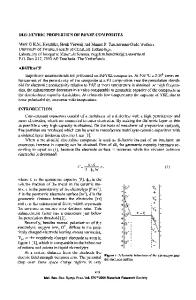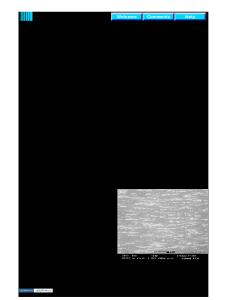Microstructure and dielectric properties of biocarbon nanofiber composites
- PDF / 694,824 Bytes
- 6 Pages / 595.28 x 793.7 pts Page_size
- 30 Downloads / 423 Views
NANO EXPRESS
Open Access
Microstructure and dielectric properties of biocarbon nanofiber composites Bo Dai1*, Yong Ren1, Gaihua Wang1, Yongjun Ma2, Pei Zhu1 and Shirong Li1
Abstract A kind of web-like carbon with interconnected nanoribbons was fabricated using bacterial cellulose pyrolyzed at various temperatures, and the microwave dielectric properties were investigated. Bacterial cellulose was converted into carbonized bacterial cellulose (CBC) with a novel three-dimensional web built of entangled and interconnected cellulose ribbons when the carbonization temperature was below 1,200°C; the web-like structure was destroyed at a temperature of 1,400°C. Composites of CBC impregnated with paraffin wax exhibited high complex permittivity over a frequency range of 2 to 18 GHz, depending on the carbonization temperature. Both real and imaginary parts were the highest for CBC pyrolyzed at 1,200°C. The complex permittivity also strongly depended on CBC loadings. For 7.5 wt.% loading, the real and imaginary permittivities were about 12 and 4.3, respectively, and the minimum reflection loss was −39 dB at 10.9 GHz. For 30 wt.% loading, the real and imaginary permittivities were about 45 and 80, respectively, and the shielding efficiency was more than 24 dB in the measured frequency range and could be up to 39 dB at 18 GHz. The electromagnetic properties were assumed to correlate with both the dielectric relaxation and the novel web-like structure. Keywords: Carbon fibers, Heat treatment, Electrical properties, Transmission electron microscopy (TEM)
Background The rapid proliferation of advanced electronic devices for many commercial and military applications, such as data transmission, telecommunications, wireless network systems, and satellite broadcasting as well as radar and diagnostic and detection systems, has led to numerous electromagnetic compatibility and electromagnetic interference (EMI) problems. The interaction of electromagnetic waves originating from different sources can lead to a decrease in quality and a misinterpretation of transferred data, and it has thus become vital to avoid such interference and electromagnetic wave pollution through the use of appropriate absorbing and shielding materials. Carbonaceous materials - such as graphite and/or carbon black - are often used as dielectric electromagnetic absorbers, generating dielectric loss by improving the electrical conductivity of the mixture. In particular, nanostructured materials and carbon fiber composites have been the subjects of growing interest * Correspondence: [email protected] 1 State Key Laboratory Cultivation Base for Nonmetal Composites and Functional Materials, School of Materials Science and Engineering, Southwest University of Science and Technology, Mianyang 621010, People’s Republic of China Full list of author information is available at the end of the article
as microwave radiation absorbing and shielding materials in the high-frequency range due to their fascinating properties [1-5]. It is reported that carbon nanofiber-pol
Data Loading...











